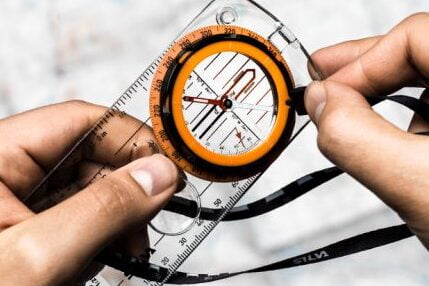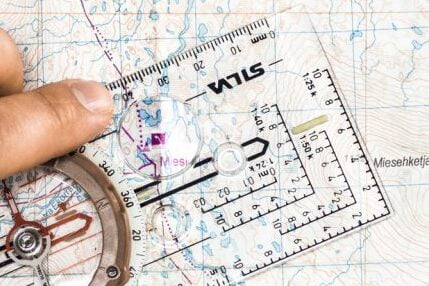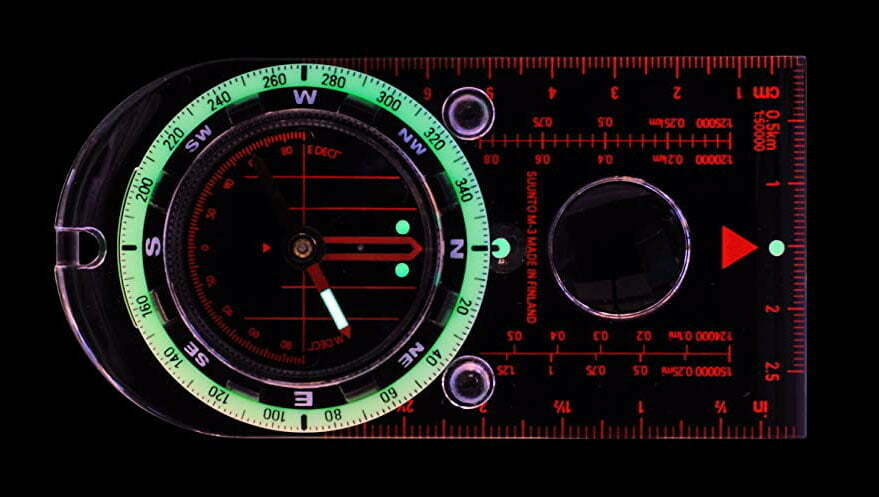Includes affiliate links that help offset our expenses at no cost to you.
With so many choices available, it can be hard to narrow down which compass is right for you. Here’s a guide to choosing the best compass for your needs.
Practically everyone is using the GPS (Global Positioning System) to find their way around the wilderness. We do it. While the GPS is cool and all, the map and compass still offer greater navigation accuracy and much more reliability. Navigating with a map and compass is one of the fundamental skills that we teach, and even if using a GPS we believe that everyone should have a compass and know how to use it.
Baseplate or Mirror?
The two most common styles are a simple baseplate-style (also called orienteering-style) compass, or a slightly more complicated mirror-style compass. Both are good choices but with different tradeoffs. A baseplate compass is typically less expensive, smaller, and faster to use because it takes extra time to open the cover of a mirror compass and sight it while watching the needle in the mirror.
The main advantage of a mirror compass is accuracy – typically one can sight a bearing within about 2 degrees using a mirror compass, versus about 5 degrees using a baseplate style. This accuracy may or may not matter to you in practice. For navigation over relatively short distances (under a kilometer for example), in areas with terrain features that also help with navigation, a baseplate compass can be perfectly adequate and easier to use. For travel over longer distances and where the terrain offers few other features to help with navigation, the increased accuracy of a mirror-style compass can be worth the moderate added cost, bulk, and time. In our land navigation classes we teach how to use both kinds.
Adjustable Declination?
A compass needle aligns itself with the local magnetic field, which is usually not aligned with true north or with the grid lines on a map used for navigation. Some compasses have a built-in adjustment mechanism that, when set correctly for the area in which you are navigating, can make it somewhat easier and faster to orient the compass toward true north or grid north. This is commonly called Adjustable Declination and compasses with this feature are slightly more expensive plus they require you to adjust the mechanism correctly before using the compass to navigate.
Without adjustable declination, one can accomplish the same thing by adding or subtracting a number of degrees when adjusting the compass for a particular bearing. We teach how to do this in our land navigation classes, and it’s not hard but one must be careful to either add or subtract the right number of degrees or it can introduce significant errors. It’s a matter of personal preference, with many people preferring the convenience of adjustable declination and others preferring to have a simpler compass without it.

Other Features?
Compasses offer a variety of other features that can be important, convenient, or just superfluous. Here’s a list of features to consider.
Balancing Zones
The earth’s magnetic field runs at an angle to horizontal, and this magnetic dip affects how a compass works. Many compasses are designed to work properly only in the Northern Hemisphere, in the Southern Hemisphere, or near the Equator. Others are designed to work worldwide.
While few people buy a compass and travel across hemispheres with it, it’s important not to buy one that’s designed to work in a different balancing zone from where it will be used. Some compasses are available in different versions that may be listed as “Northern Hemisphere” or “Worldwide” for example. Just read the description carefully to make sure you’re getting a compass that’s balanced for your region of the world, or that can be used worldwide.
Map Scales
Most compasses have a number of map scales along the edges, typically indicating miles or kilometers in common map scales such as 1:24,000 and 1:50,000. They can be convenient, but we often use smaller-scale maps at 1:15,000 or 1:10,000 and few compasses have these scales so we end up using a separate map scale anyway.
Some compasses have a lanyard with map scales built in. It could be handy for measuring longer distances on a map, and for bending around curved trails etc. But it’s definitely not a must-have feature and doesn’t work at all if the lanyard doesn’t happen to have a scale that matches your map. We wouldn’t spend any extra to get this feature.
Magnifier
A built-in magnifier can be quite handy for reading small details on a map. Some may say it’s also useful as a fire starter when used to focus bright sunlight onto flammable material, but most of them are too small to focus enough light for this purpose.

Clinometer
Some of the fancier compasses have a built-in clinometer (or inclinometer) that can be used to measure the angle of a slope, such as when using the slope of a hill to help determine one’s position on a map based on contour lines. This can be useful in theory, but we rarely use or want one in practice.
Glow in the Dark
Many compasses have glow-in-the dark rings and needles, so that one might use them in the dark. However they only glow if the compass has been recently exposed to bright light, and not kept stuffed away in a dark pocket. We do navigate at night, but if it’s dark enough to read a glowing compass then we usually are using a headlamp to read a map and see where we’re going so a glowing compass doesn’t add much value in most situations. It can be nice to have, but it’s definitely not a critical feature for most people.

Brand?
We’ll keep this very simple: buy a compass made by Silva or Sunnto. Both are quality brands and they are the de facto standard used by people who are serious about navigation, and they can be had at affordable prices. Silva’s compasses are made in China, whereas most of Suunto’s are made in Finland and are usually a little more expensive. Don’t buy a cheap off-brand compass thinking that you’re saving a few bucks, because cheaper brands have an annoying tendency to fall apart or leak.
Our Recommendations
Here are our top recommendations for compasses that offer a good value for the price. The relatively inexpensive options listed below are solid choices that are adequate for most purposes, whereas the higher-end models have more features that you may find are worth the added cost.







